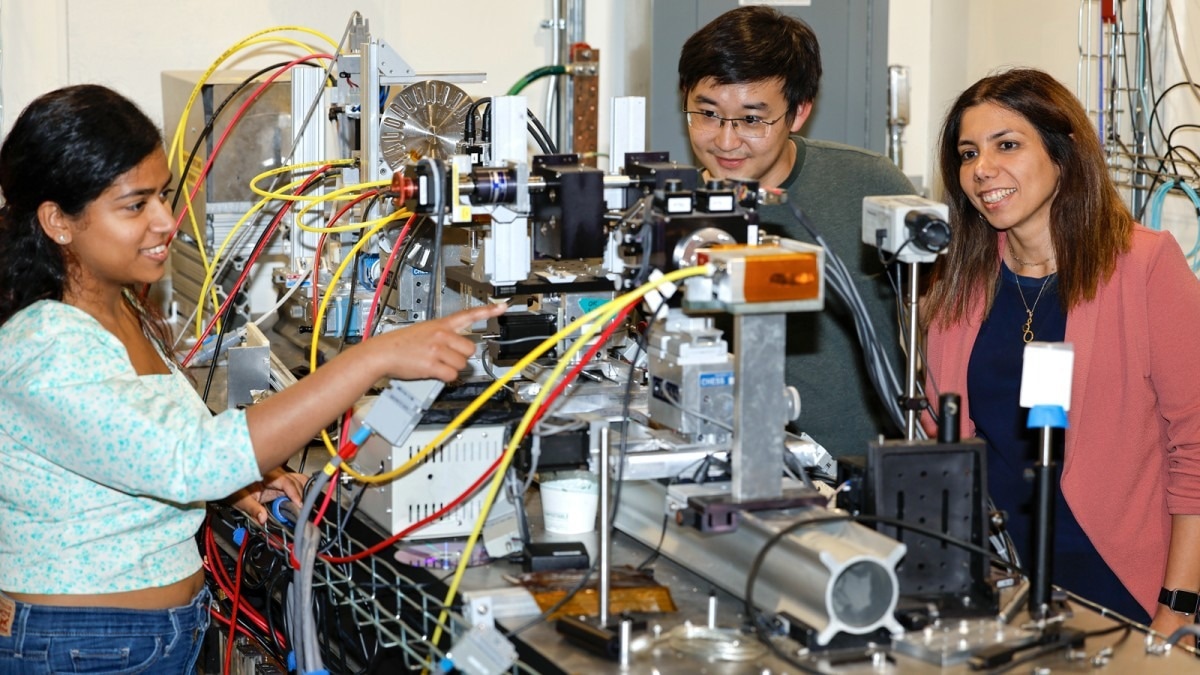Cornell researchers have adopted an innovative approach to studying the emergence of microstructure in a 3D-printed metal alloy. They used X-Ray bombardment during the printing process.
 Doctoral students Adrita Dass (left) and Chenxi Tian, and Atieh Moridi, assistant professor in the Sibley School of Mechanical and Aerospace Engineering, created a portable twin of their 3D-printing setup. Image Credit: Charissa King-O’Brien/Cornell Engineering.
Doctoral students Adrita Dass (left) and Chenxi Tian, and Atieh Moridi, assistant professor in the Sibley School of Mechanical and Aerospace Engineering, created a portable twin of their 3D-printing setup. Image Credit: Charissa King-O’Brien/Cornell Engineering.
Observing how thermomechanical deformation leads to localized microscale phenomena like bending, fragmentation, and oscillation in real time enables the production of tailored materials with performance-enhancing characteristics.
The study was published in Nature Communications Materials on October 10th, 2023, with Doctoral Student Adrita Dass, M.S. ‘20, as the lead author.
We always look at these microstructures after processing, but there’s a lot of information that you’re missing by conducting only postmortem characterizations. Now we have tools to be able to watch these microstructural evolutions as they are happening. We want to be able to understand how these tiny patterns or microstructures are formed because they dictate everything about performance of printed parts.
Atieh Moridi, Study Senior Author and Assistant Professor, Sibley School of Mechanical and Aerospace Engineering, Cornell University
The team concentrated on a specific 3D printing method using a powder, such as the widely employed nickel-based superalloy IN625 in additive manufacturing and aerospace. This powder is applied through a nozzle, melted by a high-power laser, and subsequently cools and solidifies.
To work with high-energy X-Rays, which are not accessible in their lab, the researchers replicated their 3D printing setup in a portable form and transported it to the Center for High Energy X-Ray Sciences at the Cornell High Energy Synchrotron Source (CHEXS@CHESS) located in Wilson Laboratory.
As the facility had not previously performed this type of 3D printing experiment, the CHESS beamline scientist, Darren Pagan (now an Assistant Professor at Pennsylvania State University), collaborated with the researchers to incorporate the printer setup within one of the facility's experimental enclosures. Additionally, the CHESS team devised essential safety procedures for operating a high-power laser in conjunction with flammable powders.
During the experiment at the FAST beamline, a concentrated X-Ray beam was directed into the enclosure, where it traversed the IN625 as it underwent the process of heating, melting, and subsequent cooling. A detector situated on the opposite side of the printer recorded the diffraction patterns arising from the interaction between the X-Rays and the material.
The way these diffraction patterns form gives us a lot of information about the structure of the material. They are the microstructural fingerprints that capture the history of the material during the processing. Depending on the interaction and what caused it, we get different patterns, and from those patterns, we can back calculate the structure of the material.
Atieh Moridi, Study Senior Author and Assistant Professor, Sibley School of Mechanical and Aerospace Engineering, Cornell University
Usually, researchers aim to condense the volume of diffraction data for analysis. However, Moridi, Dass, and co-author Chenxi Tian, M.S. '22, took on a more demanding endeavor by examining the raw detector images.
Although this method consumed more time and demanded increased manual effort, it yielded a more comprehensive and insightful perspective on the formation of IN625. This approach unveiled “unique features that most of the time we’re missing,” Moridi added.
The team pinpointed critical microstructural characteristics generated by the thermal and mechanical impacts of the process, including torsion, bending, fragmentation, assimilation, oscillation, and interdendritic growth.
The researchers foresee that their approach can be extended to other 3D-printed metals like stainless steel, titanium, high-entropy alloys, or any material system with a crystal structure.
Additionally, this method can contribute to the advancement of more robust materials. For instance, modulating a laser beam could enhance internal fragmentation within a crystal and diminish the size of its grains, resulting in increased material strength.
Dass adds, “The final goal is to have the best material system that we can have for that particular alloy for a particular application. If you know what is happening during processing, you can choose how to process your materials, so you get those specific features.”
This research received backing from the National Science Foundation (NSF) and the US Department of Energy's Office of Science. The researchers also took advantage of the Cornell Center for Materials Research and CHEXS@CHESS, both of which receive support from the NSF.
Journal Reference:
Dass, A., et al. (2023). Dendritic deformation modes in additive manufacturing revealed by operando x-ray diffraction. Communications Materials. doi.org/10.1038/s43246-023-00404-0.